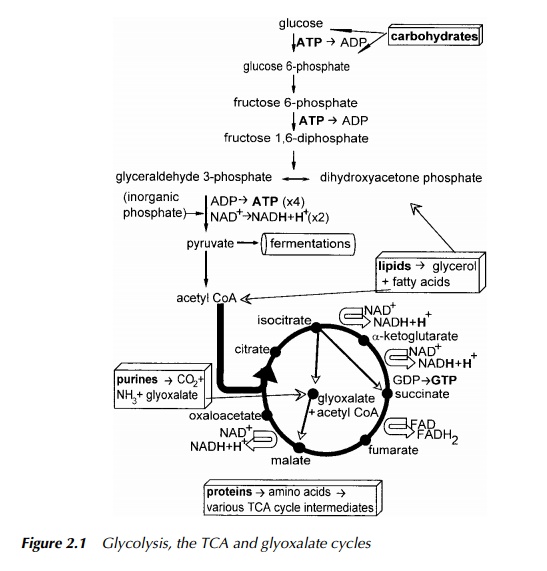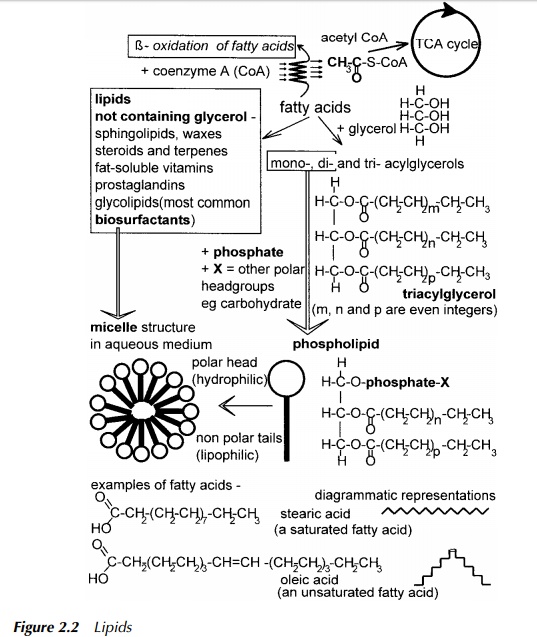Chapter: Environmental Biotechnology: Microbes and Metabolism
Metabolism
Metabolism
The energy required to carry out all cellular processes is obtained
from ingested food in the case of chemotrophic cells, additionally from light
in the case of phototrophs and from inorganic chemicals in lithotrophic
organisms. Since all biological macromolecules contain the element carbon, a
dietary source of carbon is a requirement. Ingested food is therefore, at the
very least, a source of energy and carbon, the chemical form of which is
rearranged by passage through various routes called metabolic pathways. One
purpose of this reshuffling is to produce, after addition or removal of other
elements such as hydrogen, oxygen, nitrogen, phosphorous and sulphur, all the
chemicals necessary for growth. The other is to produce chemical energy in the
form of adenosine triphosphate (ATP), also one of the ‘building blocks’ of
nucleic acids. Where an organism is unable to synthesise all its dietary
requirements, it must ingest them, as they are, by definition, essential
nutrients. The profile of these can be diagnostic for that organism and may be
used in its identification in the laboratory. An understanding of nutritional
requirements of any given microbe, can prove essential for successful
remediation by bioenhancement.
At the core of metabolism
are the central metabolic pathways of glycolysis and the tricarboxylic acid
(TCA) cycle on which a vast array of metabolic pathways eventually converge or
from which they diverge. Glycolysis is the conversion of the six-carbon
phosphorylated sugar, glucose 6-phosphate, to the three-carbon organic acid,
pyruvic acid, and can be viewed as pivotal in central metabolism since from
this point, pyruvate may enter various pathways determined by the energy and
synthetic needs of the cell at that time. A related pathway, sharing some but
not all of the reactions of glycolysis, and which operates in the opposite
direction is called gluconeogenesis. Pyruvate can continue into the TCA cycle
whose main function is to produce and receive metabolic intermediates and to
produce energy, or into one of the many fermentation routes.
The principles of glycolysis
are universal to all organisms known to date, although the detail differs
between species. An outline of glycolysis, the TCA, and its close relative the
glyoxalate, cycles is given in Figure 2.1, together with an indication of the
key points at which the products of macromolecule catabolism,

or breakdown, enter these central metabolic pathways. The focus is
on degrada-tion rather than metabolism in general, since this is the crux of
bioremediation. A description of the biological macromolecules which are
lipids, carbohydrates, nucleic acids and proteins are given in the appropriate
figures (Figures 2.2 – 2.5).

Not all possible metabolic
routes are present in the genome of any one organ-ism. Those present are the
result of evolution, principally of the enzymes which catalyse the various
steps, and the elements which control their expression. However, an organism
may have the DNA sequences, and so have the genetic capability for a metabolic
route even though it is not ‘switched on’. This is the basis for the
description of ‘latent pathways’ which suggests the availability of a

route able to be activated when the need arises, such as challenge
from a novel chemical in the environment. Additionally, there is enormous
potential for uptake and exchange of genetic information as discussed earlier.
It is the enormous range of metabolic capability which is harnessed in
environmental biotechnology.

The basis of this discipline
is about ensuring that suitable organisms are present which have the capability
to perform the task required of them. This demands the provision of optimal
conditions for growth, thus maximising degradation or removal of the
contaminant. Linked to many of the catalytic steps in the metabolic pathway are
reactions which release sufficient energy to allow the synthesis of ATP. This
is the energy ‘currency’ of a cell which permits the transfer of energy

Related Topics